Abstract
Although enhanced sensitivity of erythrocytes to complement-mediated lysis is a hallmark of paroxysmal nocturnal hemoglobinuria (PNH), subpopulations of erythrocytes in such patients vary significantly in this respect. One PNH erythrocyte subpopulation (termed type III) comprises exquisitely sensitive cells, whereas type II PNH erythrocytes are intermediate in complement sensitivity between PNH type III and normal human erythrocytes. Differences in the action of the terminal complement components that would account for the differing lytic behavior of types II and III PNH erythrocytes have been proposed but not directly demonstrated.
The present studies, making use of carefully selected cases with pure populations of type II or type III erythrocytes, confirm a prior observation that antibody-coated PNH erythrocytes of both types II and III display comparably supranormal C3 binding in whole human serum. However, when lysis was induced by the isolated C5b-9 membrane attack mechanism, bypassing the requirement for C3 binding, only type III PNH cells exhibited greater than normal lysis. This finding suggests that type III PNH erythrocytes have an additional membrane abnormality not present in type II cells. Thus, the differing lytic behavior of these two cell types in whole serum may reflect the additive effects on type III cells of both exaggerated C3 binding and enhanced sensitivity to C5b-9, whereas the more moderate lysis of type II PNH cells may be determined mainly or entirely by the earlier-acting mechanism producing augmented C3 binding.
The failure of guinea pig C8 and C9, as opposed to human C8 and C9, to reveal the true lytic sensitivity of PNH-III E in our earlier study is illustrated, and its implications briefly discussed.
Full text
PDF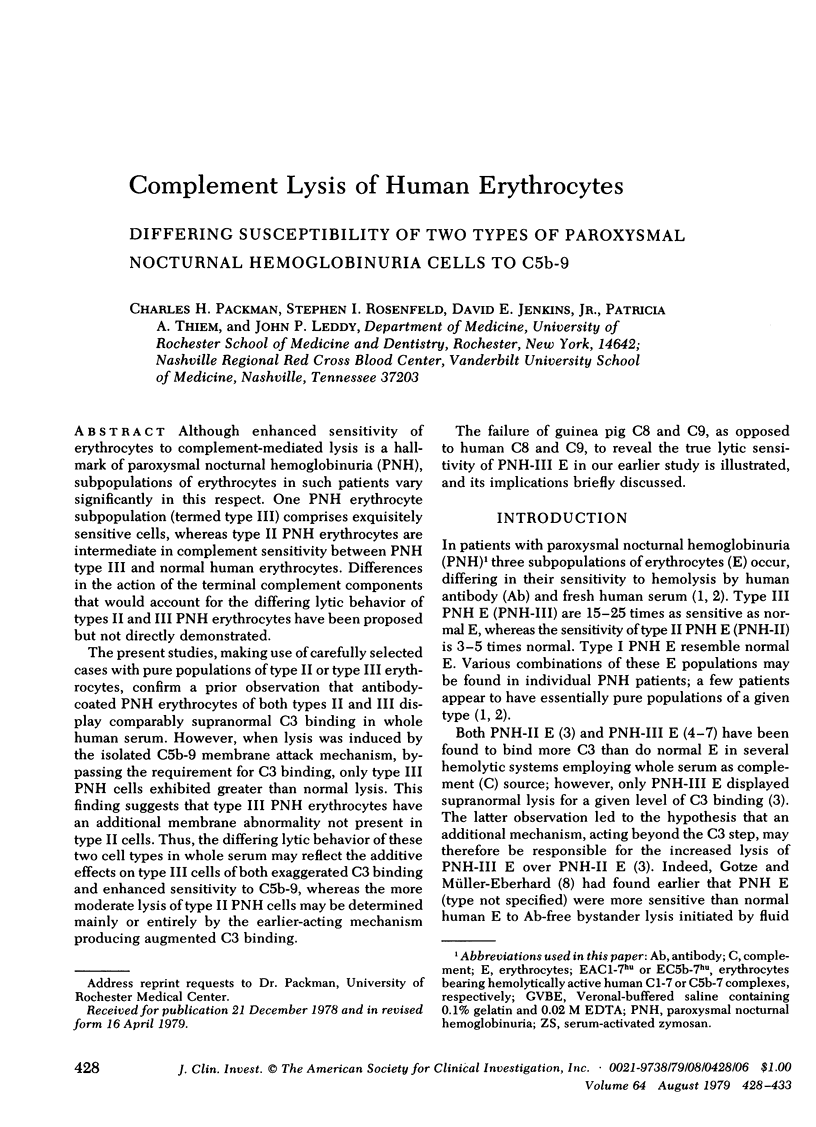
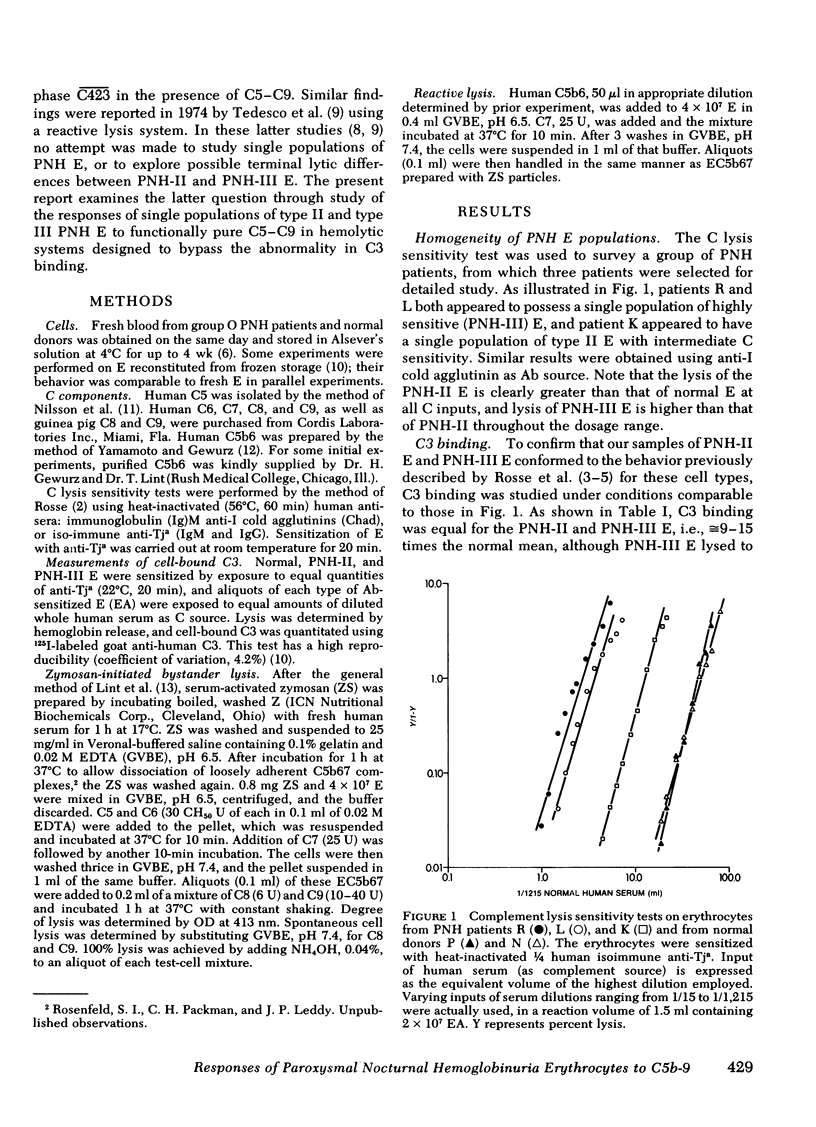
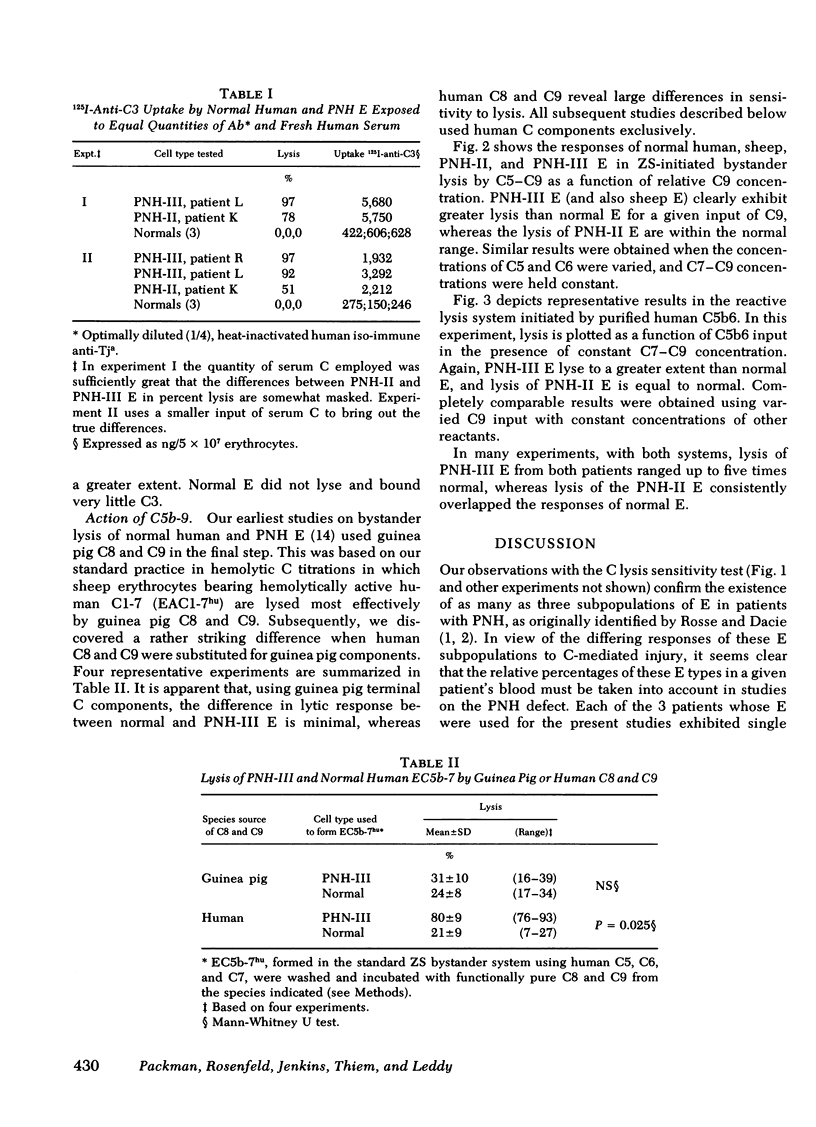
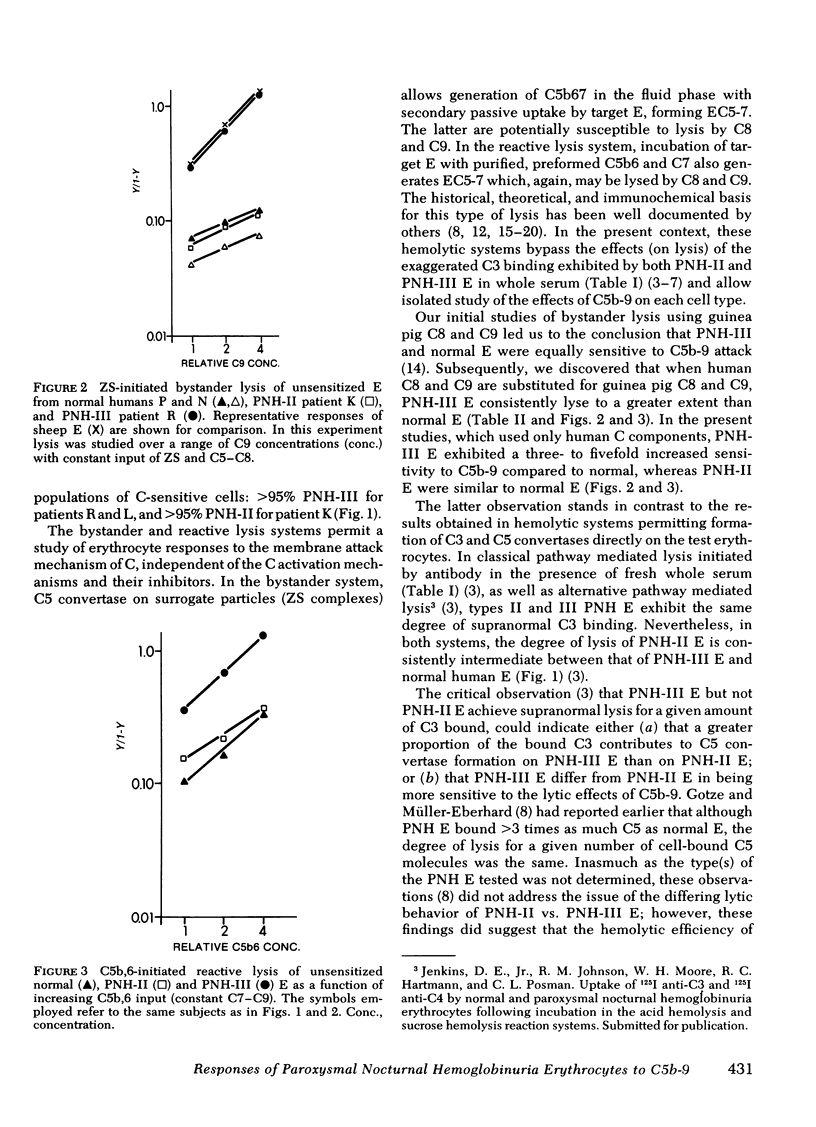
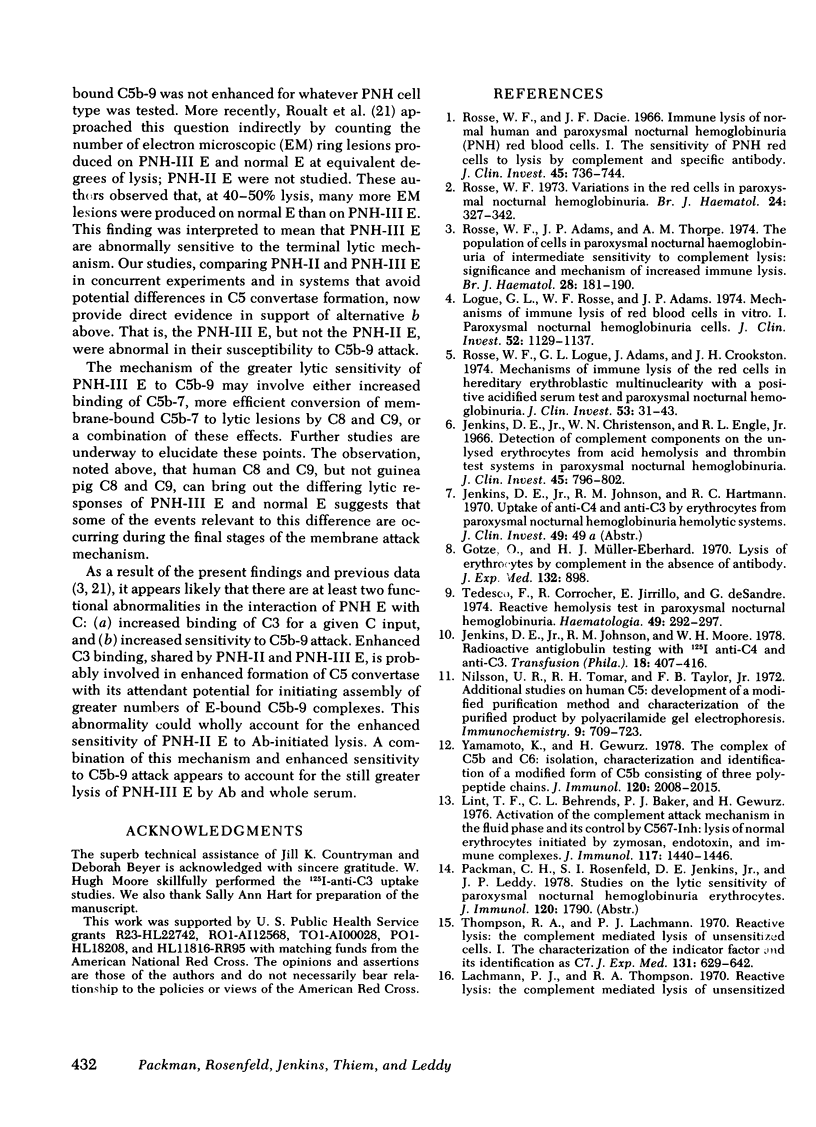
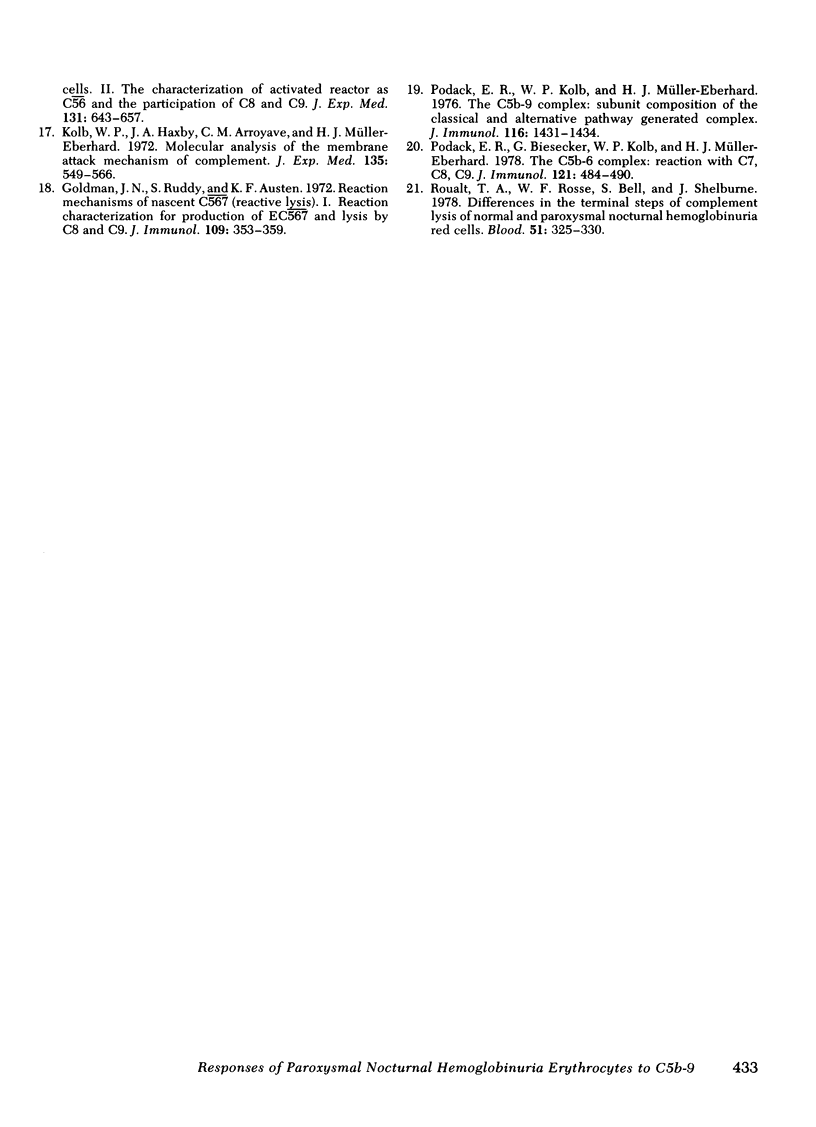
Selected References
These references are in PubMed. This may not be the complete list of references from this article.
- Goldman J. N., Ruddy S., Austen K. F. Reaction mechanisms of nascent C567 (reactive lysis). I. Reaction characteristics for production of EC567 and lysis by C8 and C9. J Immunol. 1972 Aug;109(2):353–359. [PubMed] [Google Scholar]
- Götze O., Müller-Eberhard H. J. Lysis of erythrocytes by complement in the absence of antibody. J Exp Med. 1970 Nov;132(5):898–915. doi: 10.1084/jem.132.5.898. [DOI] [PMC free article] [PubMed] [Google Scholar]
- Jenkins D. E., Jr, Christenson W. N., Engle R. L., Jr Detection of complement components on unlysed erythrocytes from acid hemolysis and thrombin test reactions in paroxysmal nocturnal hemoglobinuria. J Clin Invest. 1966 May;45(5):796–802. doi: 10.1172/JCI105394. [DOI] [PMC free article] [PubMed] [Google Scholar]
- Jenkins D. E., Jr, Johnson R. M., Moore W. H. Radioactive antiglobulin testing with 125I anti-C4 and anti-C3. Transfusion. 1978 Jul-Aug;18(4):407–416. doi: 10.1046/j.1537-2995.1978.18478251233.x. [DOI] [PubMed] [Google Scholar]
- Kolb W. P., Haxby J. A., Arroyave C. M., Müller-Eberhard H. J. Molecular analysis of the membrane attack mechanism of complement. J Exp Med. 1972 Mar 1;135(3):549–566. doi: 10.1084/jem.135.3.549. [DOI] [PMC free article] [PubMed] [Google Scholar]
- Lachmann P. J., Thompson R. A. Reactive lysis: the complement-mediated lysis of unsensitized cells. II. The characterization of activated reactor as C56 and the participation of C8 and C9. J Exp Med. 1970 Apr 1;131(4):643–657. doi: 10.1084/jem.131.4.643. [DOI] [PMC free article] [PubMed] [Google Scholar]
- Lint T. F., Behrends C. L., Baker P. J., Gewurz H. Activation of the complement attack mechanism in the fluid phase and its control by C567-INH: lysis of normal erythrocytes initiated by zymosan, endotoxin, and immune complexes. J Immunol. 1976 Nov;117(5 Pt 1):1440–1446. [PubMed] [Google Scholar]
- Logue G. L., Rosse W. F., Adams J. P. Mechanisms of immune lysis of red blood cells in vitro. I. Paroxysmal nocturnal hemoglobinuria cells. J Clin Invest. 1973 May;52(5):1129–1137. doi: 10.1172/JCI107279. [DOI] [PMC free article] [PubMed] [Google Scholar]
- Nilsson U. R., Tomar R. H., Taylor F. B., Jr Additional studies on human C5: development of a modified purification method and characterization of the purified product by polyacrylamide gel electrophoresis. Immunochemistry. 1972 Jul;9(7):709–723. doi: 10.1016/0019-2791(72)90015-8. [DOI] [PubMed] [Google Scholar]
- Podack E. R., Biesecker G., Kolb W. P., Müller-Eberhard H. J. The C5b-6 complex: reaction with C7, C8, C9. J Immunol. 1978 Aug;121(2):484–490. [PubMed] [Google Scholar]
- Podack E. R., Kolb W. P., Muller-Eberhard H. J. The C5b-9 complex: subunit composition of the classical and alternative pathway-generated complex. J Immunol. 1976 May;116(5):1431–1434. [PubMed] [Google Scholar]
- Rosse W. F., Adams J. P., Thorpe A. M. The population of cells in paroxysmal nocturnal haemoglobinuria of intermediate sensitivity to complement lysis: significance and mechanism of increased immune lysis. Br J Haematol. 1974 Oct;28(2):181–190. doi: 10.1111/j.1365-2141.1974.tb06652.x. [DOI] [PubMed] [Google Scholar]
- Rosse W. F., Dacie J. V. Immune lysis of normal human and paroxysmal nocturnal hemoglobinuria (PNH) red blood cells. I. The sensitivity of PNH red cells to lysis by complement and specific antibody. J Clin Invest. 1966 May;45(5):736–748. doi: 10.1172/JCI105388. [DOI] [PMC free article] [PubMed] [Google Scholar]
- Rosse W. F., Logue G. L., Adams J., Crookston J. H. Mechanisms of immune lysis of the red cells in hereditary erythroblastic multinuclearity with a positive acidified serum test and paroxysmal nocturnal hemoglobinuria. J Clin Invest. 1974 Jan;53(1):31–43. doi: 10.1172/JCI107551. [DOI] [PMC free article] [PubMed] [Google Scholar]
- Rosse W. F. Variations in the red cells in paroxysmal nocturnal haemoglobinuria. Br J Haematol. 1973 Mar;24(3):327–342. doi: 10.1111/j.1365-2141.1973.tb01657.x. [DOI] [PubMed] [Google Scholar]
- Rouault T. A., Rosse W. F., Bell S., Shelburne J. Differences in the terminal steps of complement lysis of normal and paroxysmal nocturnal hemoglobinuria red cells. Blood. 1978 Feb;51(2):325–330. [PubMed] [Google Scholar]
- Thompson R. A., Lachmann P. J. Reactive lysis: the complement-mediated lysis of unsensitized cells. I. The characterization of the indicator factor and its identification as C7. J Exp Med. 1970 Apr 1;131(4):629–641. doi: 10.1084/jem.131.4.629. [DOI] [PMC free article] [PubMed] [Google Scholar]
- Yamamoto K. I., Gewurz G. The complex of C5b and C6: isolation, characterization, and identification of a modified form of C5b consisting of three polypeptide chains. J Immunol. 1978 Jun;120(6):2008–2015. [PubMed] [Google Scholar]


